7.2 Vertebrate Groups
Fishes
Fishes are the most ancient and diverse group of vertebrates, with an estimated 31,000 living species. They were the first vertebrates to evolve, and the earliest of these were jawless fishes. Today’s jawless fishes are distinct from invertebrate chordates due to their cranium and complex sense organs, including eyes.
Unlike sessile, filter-feeding invertebrates, fishes are active feeders and occupy a wide range of aquatic habitats. Most fishes have a lateral line system, which detects movement and vibrations in the water. It is considered the equivalent of “hearing” in terrestrial vertebrates. The lateral line is visible as a darker stripe that runs along the length of the fish’s body.
Jawless Fishes
Jawless fishes represent an ancient lineage of craniates (animals with a skull), which includes all chordates except tunicates and lancelets. These fishes first appeared over 500 million years ago.
Major groups of jawless fishes include:
Hagfishes
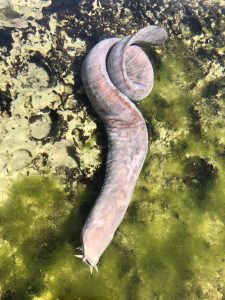
Hagfishes are eel-like scavengers that live on the ocean floor and feed on dead or dying animals. They are known to enter the bodies of these carcasses to devour them from the inside. They are entirely marine and are found in oceans worldwide, except in polar regions. A unique feature of hagfishes is their ability to secrete large amounts of slime (mucus) from specialized glands to help them escape from the grip of predators. Their skeleton is made of cartilage and includes a flexible notochord and a skull, but they lack a vertebral column, so they are not considered true vertebrates.
Lampreys
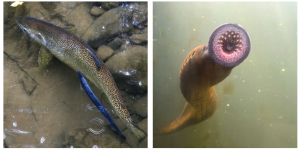
Lampreys resemble hagfishes in shape and size but differ in having a braincase and rudimentary vertebrae. They also lack paired fins and bones. Adult lampreys have a toothed, funnel-like mouth used by some species to parasitize other fish. Most lampreys, however, are free-living. They are found in coastal and freshwater environments across temperate regions. All lampreys spawn in freshwater, where their larvae live as suspension feeders for several years before maturing, reproducing, and dying shortly after.
Jawed Fishes
The evolution of jaws was a major milestone in vertebrate history. Jaws are hinged structures attached to the skull and enabled early fishes to grasp and process a wider variety of food sources that were unavailable to jawless fishes. They also have paired fins, which make them agile swimmers.
Major groups of jawed fishes include:
Cartilaginous Fishes
Cartilaginous fishes, such as sharks and rays, have skeletons made of cartilage. Some parts of their skeletons are reinforced with calcium carbonate, but this is not actual bone. Most cartilaginous fishes are marine, but there are a few freshwater species. Sharks are typically carnivorous, using their sharp teeth to capture and tear prey. Sharks have evolved replenishing teeth – as older teeth are lost or worn down, new ones move forward from rows within the jaw to take their place, ensuring they always have functional teeth for feeding.
Sharks also possess highly developed sensory systems, including a keen sense of smell and electroreception (the ability to detect electrical fields produced by other organisms). Many shark species must swim continuously to maintain water flow over their gills and to keep breathing.

Rays are closely related to sharks but have flattened bodies, enlarged pectoral fins fused to the head, and gill slits on their underside. They are mostly bottom-dwellers in marine environments.
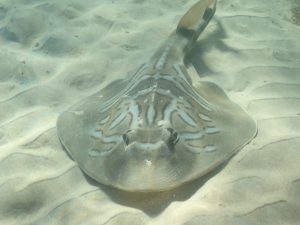
Bony Fishes
Bony fishes are the largest and most diverse group of vertebrates, with around 30,000 known species. They are characterized by a skeleton made primarily of bone, which provides strong structural support and allows for a wide range of body shapes. Their skin is typically covered in overlapping scales, and mucus-secreting glands help reduce drag while swimming. Unlike many cartilaginous fishes, bony fishes often rely heavily on vision to locate prey. Additionally, their gills are covered by a protective flap, called the operculum, which allows them to ventilate their gills without needing to swim. Another key adaptation in this group is the swim bladder, a gas-filled organ that helps regulate buoyancy.
Bony fishes are divided into two groups:
- Ray-finned fishes: This group includes the most familiar fishes such as tuna, trout, bass, and salmon. Their fins are supported by long, flexible rays.
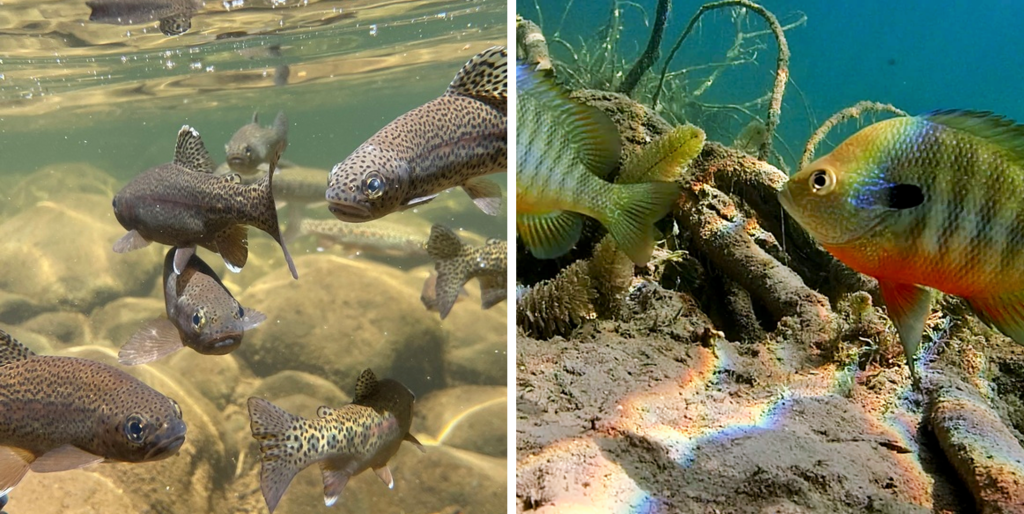
Figure 7.2.5 Rainbow Trout (left) by pashaefface, CC BY 4.0, Plains Longear Sunfish (right) by kjhurme, CC BY 4.0 - Lobe-finned fishes: These fishes have fleshy, lobed fins supported by bones. Living examples include the less familiar fishes, such as lungfishes. These fishes are especially important in evolutionary history, as they gave rise to the first land vertebrates.

Amphibians
Amphibians are vertebrate tetrapods, meaning they typically have four limbs. This group includes frogs and salamanders. The name amphibian means “dual life,” referring to their life cycle, which often includes both aquatic and terrestrial stages.
Amphibian reproduction typically occurs in moist environments, where eggs are fertilized externally. The eggs hatch into larvae, commonly called tadpoles, that are usually herbivorous, gilled, and limbless. As they mature, tadpoles undergo a metamorphosis, a transformation where they develop lungs, limbs, and a carnivorous diet. This process allows them to transition from an aquatic to a terrestrial lifestyle. Some species also exhibit parental care, such as carrying eggs or tadpoles on their backs or legs.

Modern amphibians have moist, permeable skin that contains mucus-secreting glands. This skin plays a vital role in cutaneous respiration, allowing for gas exchange directly with the environment. All adult amphibians are carnivorous, and many terrestrial species use a sticky tongue to capture prey.
Major groups of amphibians include:
Salamanders
Salamanders typically have elongated bodies, tails, and four limbs. There are around 500 species, with some living in water, others on land, and some transitioning between the two.
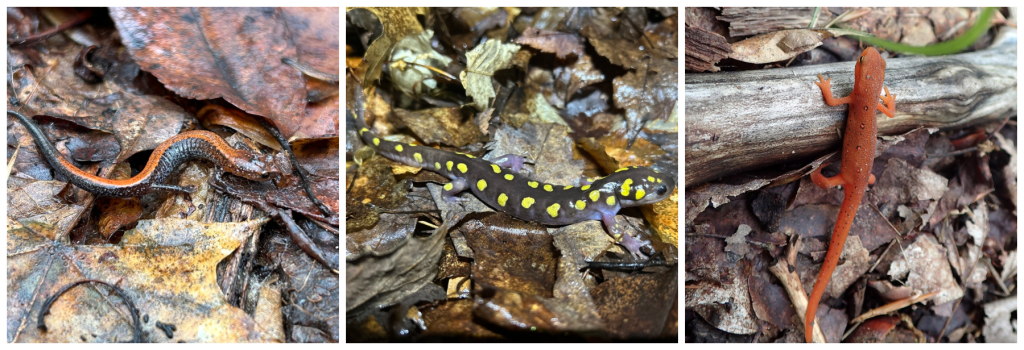
Frogs
Frogs are the most diverse amphibian group, with about 5000 species. They have a body plan specialized for jumping, with long, muscular hind limbs. Frogs use various strategies to avoid predators, including camouflage and poisonous skin secretions.
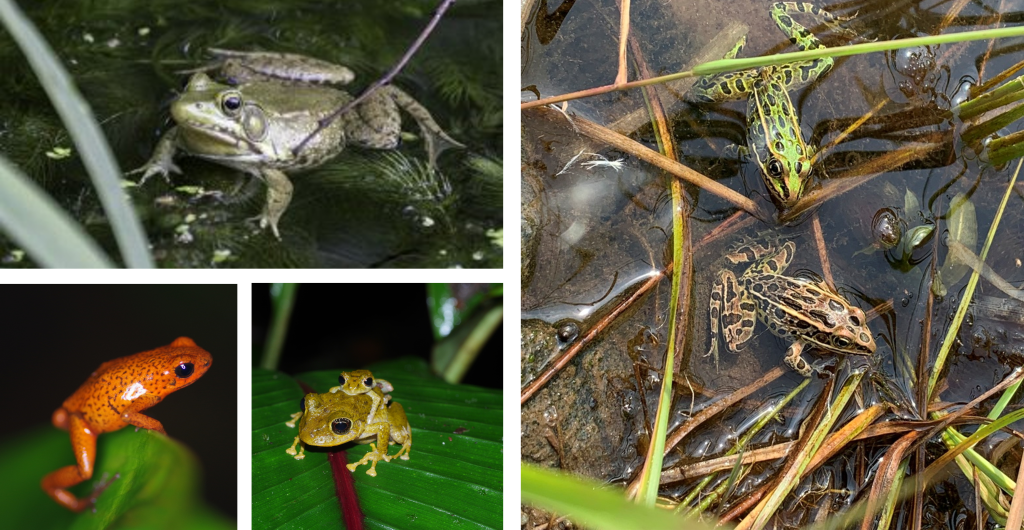
Amphibians were the earliest vertebrates to adapt to life on land. They evolved from lobe-finned fishes over 360 million years ago. These early amphibians developed key adaptations such as limbs for movement on land, lungs for breathing air, and stronger skeletal structures to support their bodies outside of water. The emergence of amphibians represents a major evolutionary milestone that bridges the gap between fully aquatic fishes and the later emergence of fully terrestrial reptiles.
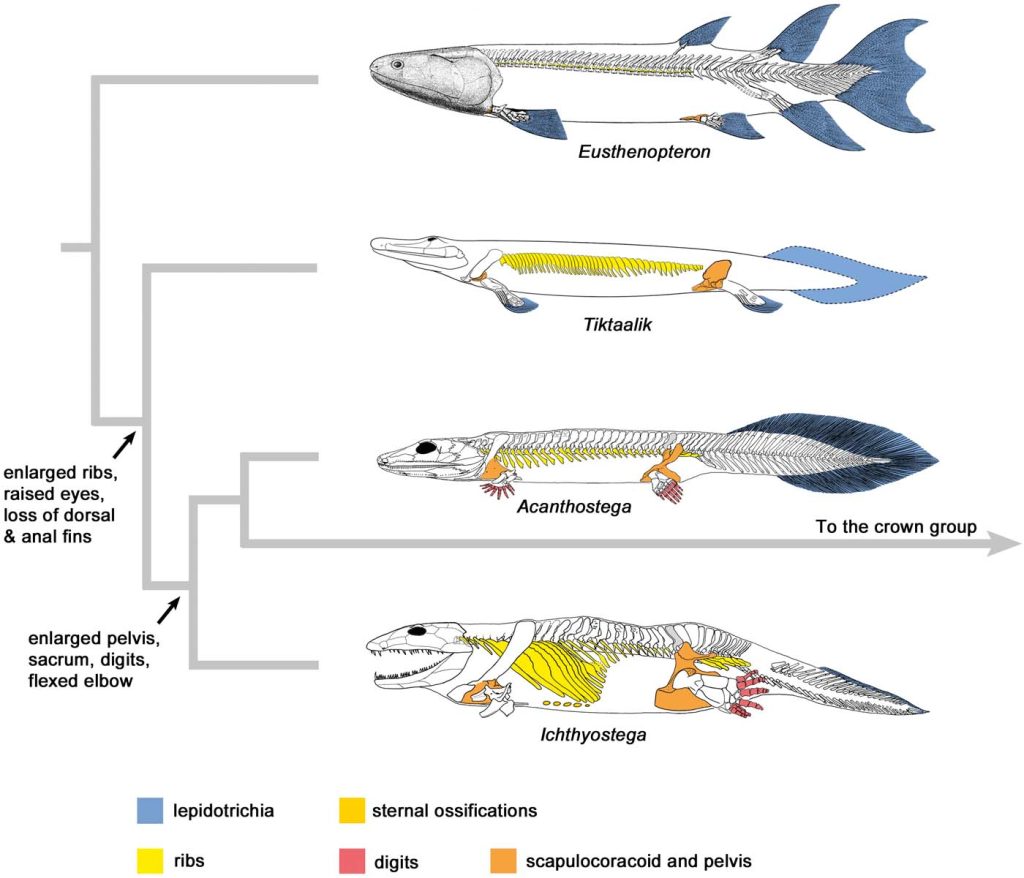
Reptiles and Birds
The amniotes—which include reptiles, birds, and mammals—are distinguished from amphibians by their amniotic egg, an evolutionary adaptation that allowed vertebrates to reproduce away from water. The amniotic membranes within the egg create a self-contained aquatic environment, enabling gas exchange, waste storage, and water retention. This adaptation reduced dependence on moist habitats and allowed amniotes to colonize drier environments. The shells of reptile eggs are more leathery and flexible. The shells of bird eggs are composed of calcium carbonate and are hard and brittle, but possess pores for gas exchange. Most mammals do not lay eggs, but even with internal development (gestation), amniotic membranes are still present.
Although birds are now understood to be a lineage of reptiles, they are often discussed separately due to their many unique adaptations. In this section, we will explore reptiles and birds as distinct groups, while recognizing their shared evolutionary history.
Reptiles
Reptiles are tetrapods, although some, like snakes, have lost their limbs through evolution. All reptiles reproduce using shelled, amniotic eggs, which are laid on land—even by aquatic species like sea turtles. Most reproduce sexually with internal fertilization.
A key adaptation for life on land is their scaly skin, which prevents water loss. Unlike amphibians, reptiles cannot breathe through their skin and must rely entirely on lungs for respiration.
Reptiles are ectotherms – animals whose main source of body heat comes from the environment. They use behaviours like basking in the sun or seeking shade to regulate their body temperature.
Major groups of reptiles include:
Crocodilians
Crocodilians (“small lizard”) include alligators and crocodiles. They have long snouts and powerful tails. They live in tropical regions and are found in freshwater habitats, such as rivers and lakes. Some species are able to move on land, but they spend most of their time in water. Unlike most reptiles, many crocodilian species do show parental care. Females guard their nests and protect their young from predators.
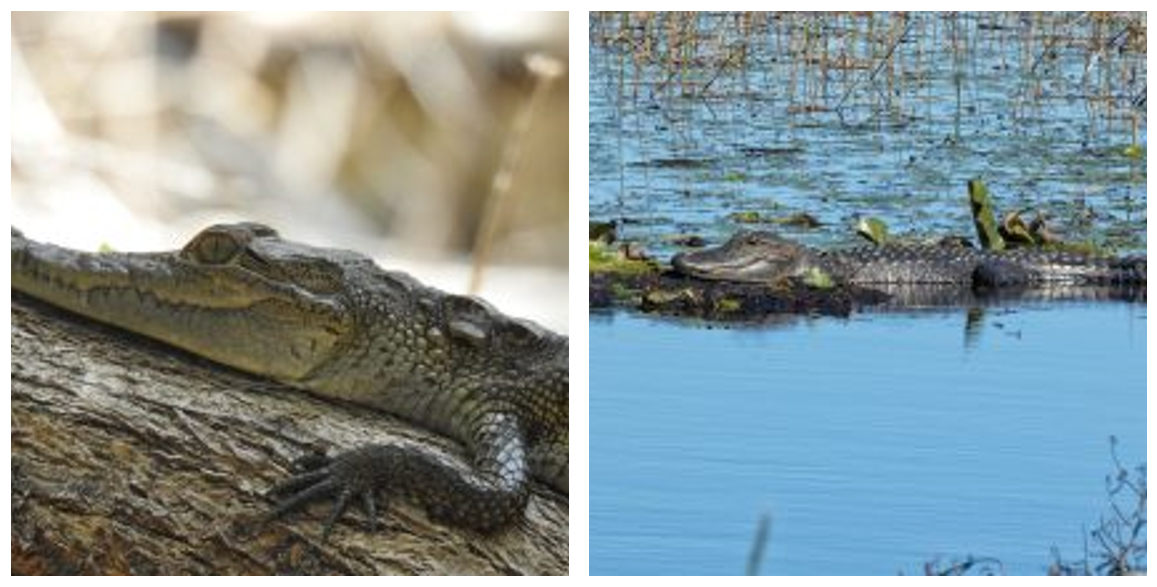
Lizards and Snakes
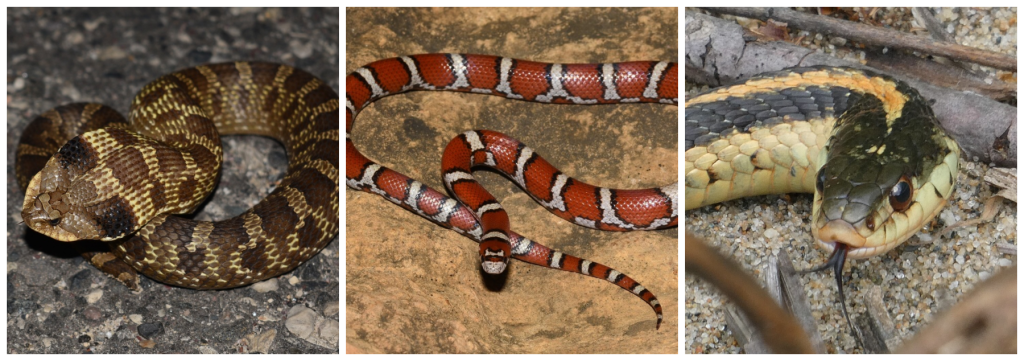
Lizards and Snakes are the most diverse group of reptiles. Lizards typically have four limbs, eyelids, and external ears, while snakes lack these features. Lizards range in size from chameleons and geckos that are a few centimetres in length to the Komodo dragon, which is about 3 meters in length. Snakes evolved from lizard-like ancestors and range in size from 10 10-centimetre-long thread snakes to 7.5-meter-long pythons and anacondas. They are entirely carnivorous, feeding on a variety of prey including small mammals, birds, and insects.
Turtles
Turtles are characterized by a bony or cartilaginous shell (carapace) made from modified ribs. Turtles lay eggs on land, even if they live in aquatic environments. They range in size from a few centimetres to the massive leatherback sea turtles (over 2m). The term “turtle” is often used to describe those that live in aquatic environments, whereas “tortoise” refers to those that live on land.
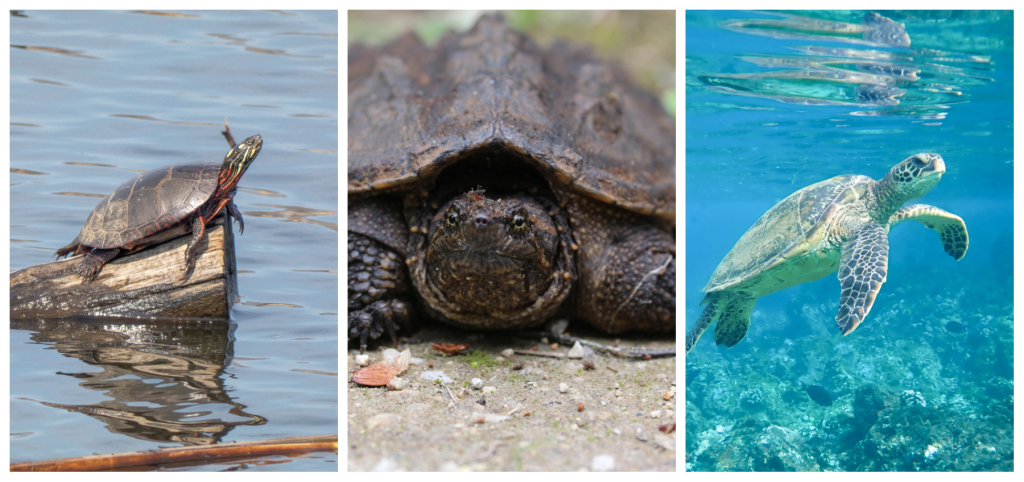
Birds
Birds are a specialized group of reptiles that evolved from theropod dinosaurs. Unlike reptiles, birds are endothermic, generating their own body heat through metabolism. Their most distinctive feature is feathers, which are modified scales. Birds have several different types of feathers that are specialized for specific functions, like contour feathers that streamline the bird’s exterior and loosely structured down feathers that insulate.
Birds have evolved numerous adaptations for flight:
- Feathers that streamline the body and provide lift
- Hollow bones to reduce weight while maintaining strength
- A fused skeleton for stability during flight
- The absence of teeth and the presence of only one ovary to reduce body mass
To help keep their feathers in top condition, birds engage in a maintenance behaviour known as preening. This involves using their beak to clean, realign, and waterproof their feathers by spreading oil from a gland near the base of the tail. This oil helps maintain feather flexibility and water resistance, which is especially important for flight and insulation.
Migration is an important and widespread behaviour among birds, allowing them to exploit seasonal resources and favourable climates. Many bird species travel thousands of kilometres between breeding and wintering grounds, often navigating with remarkable precision using environmental cues like the sun, stars, and Earth’s magnetic field. Migration helps birds avoid harsh conditions, access abundant food, and find suitable nesting sites.
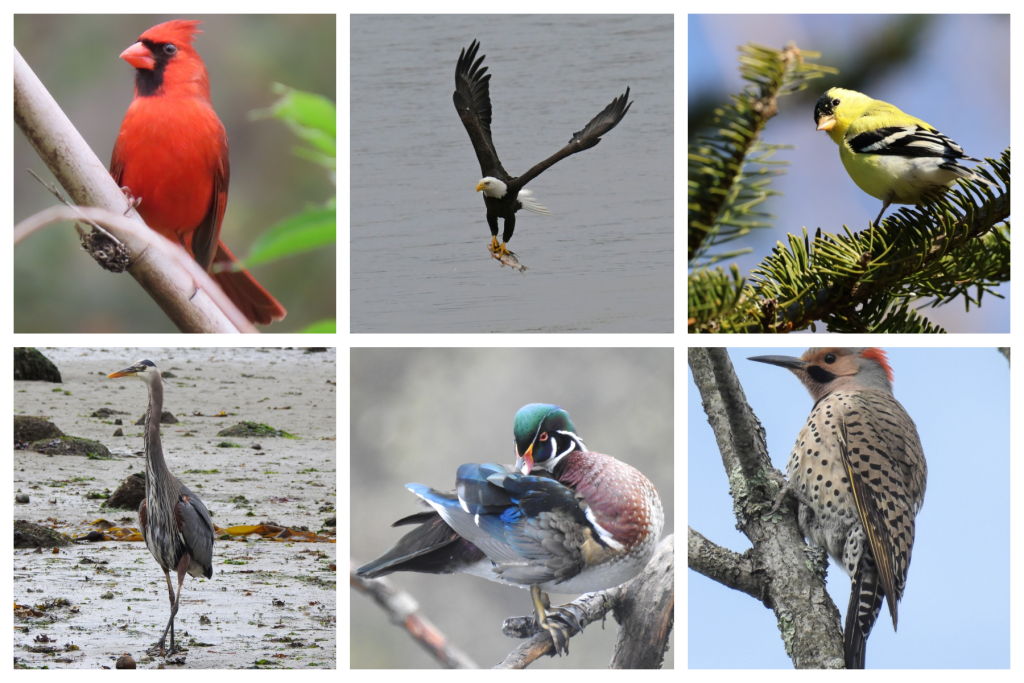
Mammals
Mammals are a diverse group of vertebrates characterized by the presence of hair and mammary glands. Mammals are endothermic, and hair provides insulation by trapping a layer of air close to the body to retain metabolic heat. Some hairs, called whiskers, are connected to nerves and function as sensory tools. Hair can also provide protective coloration.
Mammalian skin includes secretory glands with various functions. Sebaceous glands produce a lipid mixture called sebum that is secreted onto the hair and skin for water resistance and lubrication. Sudoriferous glands produce sweat for thermoregulation and scent for communication. Mammary glands produce milk that is used to feed newborns.
Mammals are classified into three major groups: monotremes, marsupials, and eutherians (placental mammals).
Monotremes
Monotremes are the most primitive group of living mammals and include just three species: the platypus and two species of echidnas. Monotremes are unique among mammals, as they lay leathery eggs, similar to those of reptiles, rather than giving birth to live young. However, the eggs are retained within the mother’s reproductive tract until they are almost ready to hatch. Once the young hatch, the female begins to secrete milk from pores in a ridge of mammary tissue along the ventral side of her body.
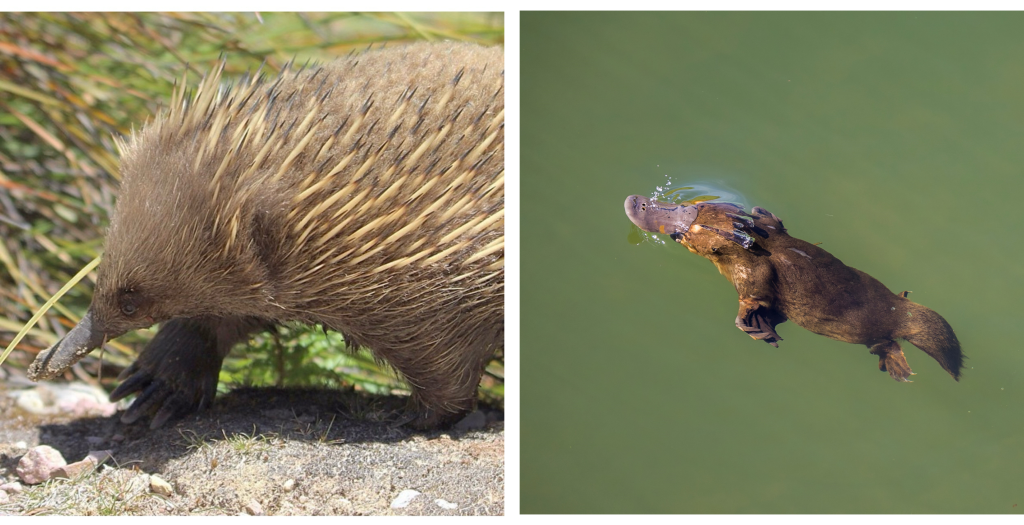
Marsupials
Marsupials give birth to underdeveloped young, which then continue to grow and nurse inside a pouch on the mother’s body. While they do form a placenta, it is less complex than that of placental mammals. Well-known marsupials include kangaroos, koalas, bandicoots, and the Tasmanian devil. Marsupials are found primarily in Australia and nearby islands, with a few species in the Americas, such as opossums.
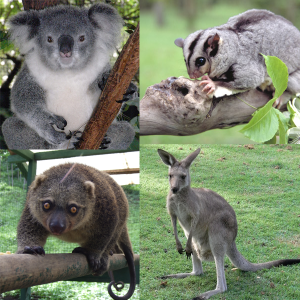
Eutherians
Eutherians, or placental mammals, are the most widespread and diverse group of mammals. They are distinguished by a complex placenta that supports the developing fetus by facilitating the exchange of nutrients, gases, and wastes between mother and offspring. This allows for a longer gestation period and more fully developed young at birth. Eutherians include a wide range of groups. Some examples include:
- Rodents – Have continuously growing incisors adapted for gnawing (e.g. mice, squirrels)
- Bats – Only mammals capable of true powered flight, with wings formed from elongated fingers and a thin membrane (e.g. big brown bats, vampire bats)
- Carnivorans – Have specialized teeth (canines) for capturing and slicing meat (e.g. dogs, cats, bears)
- Hoofed animals – Herbivorous mammals with hooves (e.g. horses, deer, pigs, whales)
- Primates – Have large brains, forward-facing eyes, and grasping hands adapted for complex behaviours (e.g. monkeys, apes, humans)
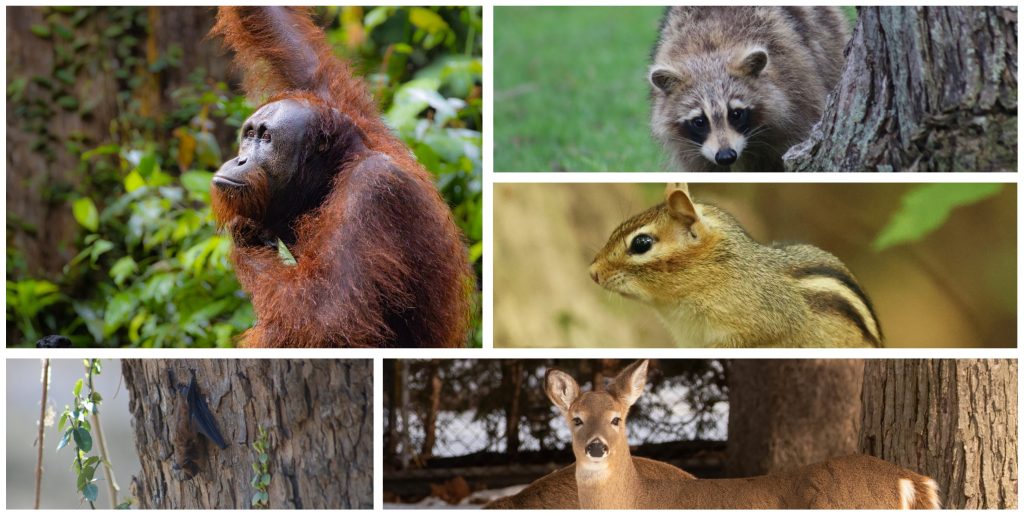
Knowledge Check
Text Description
- Open circulatory system
- Exoskeleton
- External fertilization
- Backbone made of vertebrae
- Swim bladder
- Operculum
- Amniotic egg
- External fertilization
- Hagfishes
- Ray-finned fishes
- Cartilaginous fishes
- Lobe-finned fishes
- Scaly skin
- Opposable thumbs
- Swim bladder
- Amniotic egg
Answers:
- C. Backbone made of vertebrae
- C. Amniotic egg
- D. Cartilaginous fishes
- C. Opposable thumbs
OpenAI. (2025). ChatGPT. [Large language model]. https://chat.openai.com/chat
Prompt: Create 4 multiple-choice questions using the following content
“15.6 Vertebrates” from 15.6 Vertebrates by Colleen Jones is licensed under a Creative Commons Attribution-NonCommercial-ShareAlike 4.0 International License, except where otherwise noted.

